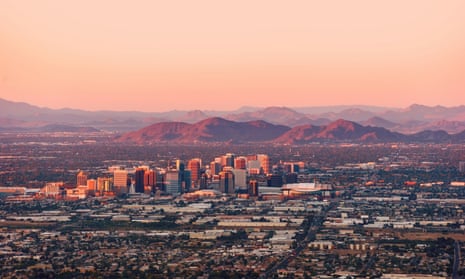The state of Arizona has restricted future home-building in the Phoenix area due to a lack of groundwater, based on projections showing that wells will run dry under existing conditions.
The action by the Arizona department of water resources on Thursday is set to slow population growth for the Phoenix region, the state capital, home to 4.6 million people and one of the most rapidly expanding areas of the United States.
The decision underscores the precarious position of Arizona in the face of a “megadrought”, fueled by the climate crisis, that has gripped the US west for the past two decades. Last week the state, along with Nevada and California, agreed to significant cutbacks in the use of water from the Colorado River, which is rapidly shrinking.
Arizona, one of the driest states in the US, gets about a third of its water from the Colorado River, with approximately another 40% coming from groundwater sources. The state’s recently concluded analysis projected a water shortfall of 4.86m acre-feet (6bn cubic meters) in the Phoenix area over the next 100 years. In response, the state said it will deny new certificates of Assured Water Supply, which enable home construction.
Arizona has imposed such restrictions on other areas, and not all of greater Phoenix requires a certificate, but experts said the measure was certain to slow home-building in an area representing over half the state’s population that has become a magnet for people in the US searching for affordable housing.
“It’s a reality check. We need to have the water supplies in order to grow,” said Sharon Megdal, director of the University of Arizona’s Water Resources Research Center.
The department of water resources said developers would need to find other sources to build.
Those sources could include officially designated entities that have excess water to sell, or farmers or Native American tribes with water rights, but all are facing short supplies given overuse and a historic drought this century.
Recycled water or desalinated brackish groundwater could also increase future supplies, Megdal said.
Katie Hobbs, Arizona’s governor, denied in a press briefing that the state was in a crisis that would prevent all future housing, pointing out that 80,000 planned housing lots will still go ahead.
“My message to Arizonans is this: we are not out of water and we will not be running out of water,” Hobbs said.
“It is also incredibly important to note that the model relates only to groundwater and does not concern surface water supplies which are a significant source of renewable water for our state. What the model ultimately shows is that our water future is secure.”
A home builders trade association said theirs was the only industry required to meet 100 years of demand for groundwater use, even though new homes have doubled their water efficiency in recent years and already restock the groundwater they consume through the Central Arizona Groundwater Replenishment District.
“We have struggled with the fact that we’re the only one that ultimately is stopped when groundwater issues arise,” said Spencer Kamps, vice-president of the Home Builders Association of Central Arizona.
